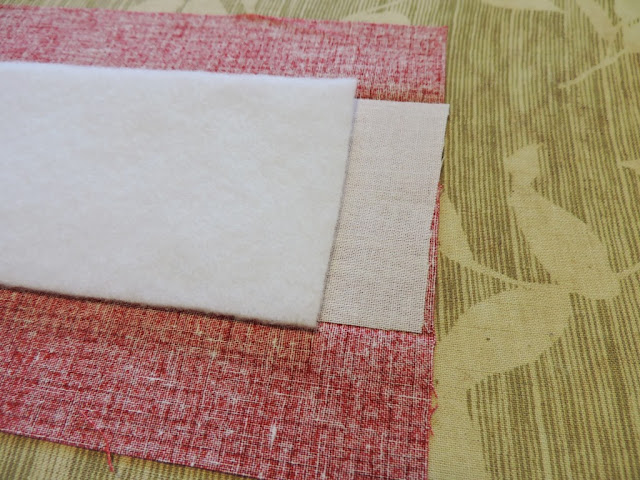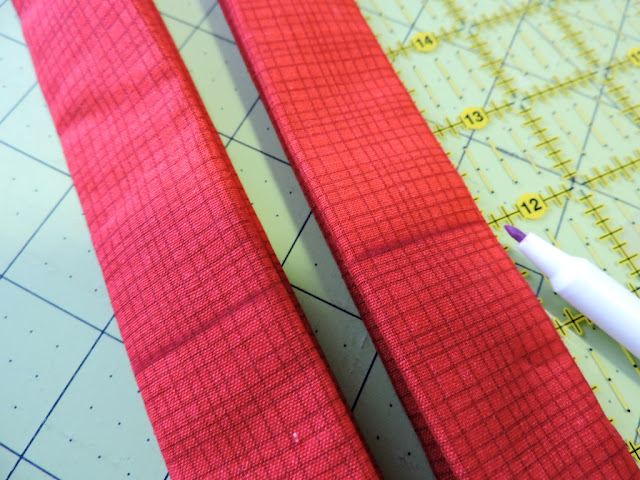Straps
We're going to start off by making the straps. I don't know why, but making straps is an annoying thing to me. I like to do them first to get them out of the way.
Take one of your strap pieces. Fold it in half length-wise, and press.
Unfold, and then fold the raw edges towards that center crease and press (like gigantic bias tape).
Unfold. Take one of your skinny strips of fusible interfacing and lay it down the center, between the creases. Press to fuse and let it cool for a few minutes to really set. Your strip won't be long enough, so grab another one and slightly overlap the edges so the length of the entire strap is covered.
Take a strip of fusible fleece, lay it down on top of the interfacing, but start it about one inch from the short edge--
The fusing part here is two-part--one is like a basting fuse, and the other is the good solid convincing fuse. I like to refold my strap like this and press--
--then turn it over and really press, getting a good fuse. Let it cool for a few minutes. Then fold it in half again and press along the fold. All raw edges are enclosed (except the short ends that will end up in a seam).
Mark a line twelve inches from each short end.
BETWEEN those lines we are going to stitch the edges of the straps about 1/8 inch from the edge (or as close as you feel comfortable). Sew from line to line, backstitching neatly at the start and stop.
Then stitch the other side, trying to get your stitching to start and stop at the same spot as the first side.
You can stop here and skip the next few steps, but I love the look of a quilted strap, so I'm going to add more stitches. For this part we are going to stitch the entire length of the strap. I want my stitching to be a certain distance from those first lines of stitches, so I line up the edge of my presser foot like so--
--and take note of where I'm lined up on my throat plate. I'm between a half inch and five eighths. I can eyeball this fine but if you're not feeling lucky you can use a small piece of tape to line up your strap against to keep the seam straight. Now, I remove the strap and put it back under with the short end being my start point, lined up with the reference point I just noted--
--and stitch the whole length of the strap. Repeat for the other edge of the strap. You should have something like this--
Repeat for the other strap and give them another press. Pressing is the secret ingredient to a neat finish on anything you sew, so get in the habit of doing that.
The Front Pocket
Remember that two-inch by eight inch strip we cut? Get that. Fold and press in half lengthwise, then fold the raw edges towards the center crease and press (just like we did for the strap).
Fold in half and press again to make those creases really crisp. Now take your pocket pieces, put them wrong sides together, and fold the bias tape around the top edges, pinning in place:
Stitch close to the edge near the pocket. Check the back to make sure you've caught that edge as well.
I didn't, but if you'd like to mimic the quilty look of the straps then throw in another row or two of stitching on that binding strip.
The Bag Front/Back
Take one of your fleece pieces for the front or back of the bag. Lay your exterior fabric piece on top of it. Pretend it's one layer. I didn't do this but you can sew the layers together with a scant seam allowance if that makes you more comfortable. Mark the bottom center (a pin is fine). Mark the bottom center of your front pocket, lay it on top of the bag front, and line those center points up. I use a few pins on the pocket to keep it from squidging around.
Take one of your straps and lay it down so that it is four inches from the side edge of the bag, covering the side of the pocket. Pin in place. I like to do one end at a time.

Trot on over to your sewing machine, and line up with your previous line of stitching (the one that ran between our marked lines). Now we're going to finish that stitching while we secure the strap to the bag. So start at the line, backstitch neatly, and sew to the end. Do this for the other edge of this end of the strap.
Now, go back to that line we drew. Sew across it a few times, neatly. My sewing machine has a triple-stitch function that looks like this:
It goes forward, back and forward again for every stitch. This helps keep me from having a sloppy line of stitching.
Then, making sure the strap isn't twisted, repeat for the other end of the strap.
Now do the same thing for the back piece of the bag and the other strap (obviously you won't have a pocket this time).
We need to round those bottom corners. I use my pincushion to do this (highly technical, I know). My pincushion has a five-inch diameter, so try to find something of similar size to use to curve your bottom corners--this will ensure that your gusset and piping are long enough. Trace and trim.
It'll now look like this (I don't know why it looks so tall--there is no end to the wonders I can achieve with my camera, haha).
At this point you've got your front and back with the straps attached, one side with a pocket. Next up we'll tackle the gusset with the elastic pockets and the piping.
























Oh, no, I am behind already. I have my fabric, but it isn't cut yet. No worries though, I will catch up soon.
ReplyDelete